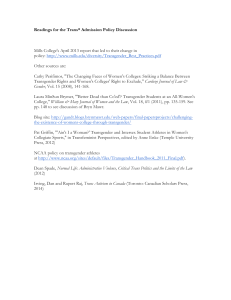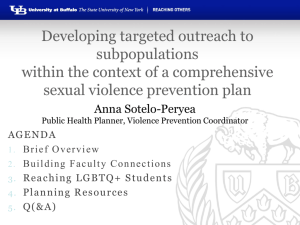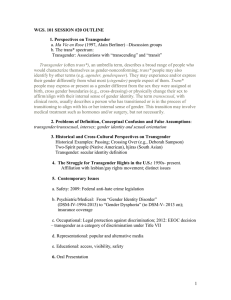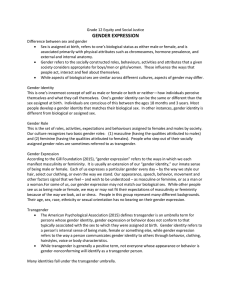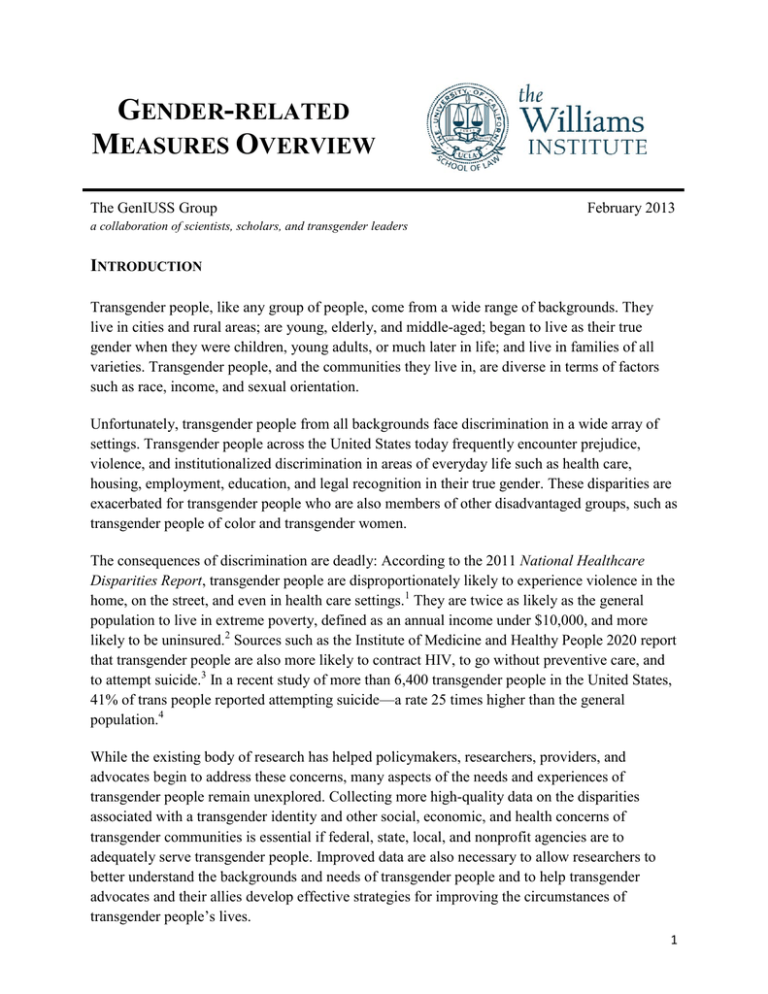
GENDER-RELATED
MEASURES OVERVIEW
The GenIUSS Group
February 2013
a collaboration of scientists, scholars, and transgender leaders
INTRODUCTION
Transgender people, like any group of people, come from a wide range of backgrounds. They
live in cities and rural areas; are young, elderly, and middle-aged; began to live as their true
gender when they were children, young adults, or much later in life; and live in families of all
varieties. Transgender people, and the communities they live in, are diverse in terms of factors
such as race, income, and sexual orientation.
Unfortunately, transgender people from all backgrounds face discrimination in a wide array of
settings. Transgender people across the United States today frequently encounter prejudice,
violence, and institutionalized discrimination in areas of everyday life such as health care,
housing, employment, education, and legal recognition in their true gender. These disparities are
exacerbated for transgender people who are also members of other disadvantaged groups, such as
transgender people of color and transgender women.
The consequences of discrimination are deadly: According to the 2011 National Healthcare
Disparities Report, transgender people are disproportionately likely to experience violence in the
home, on the street, and even in health care settings.1 They are twice as likely as the general
population to live in extreme poverty, defined as an annual income under $10,000, and more
likely to be uninsured.2 Sources such as the Institute of Medicine and Healthy People 2020 report
that transgender people are also more likely to contract HIV, to go without preventive care, and
to attempt suicide.3 In a recent study of more than 6,400 transgender people in the United States,
41% of trans people reported attempting suicide—a rate 25 times higher than the general
population.4
While the existing body of research has helped policymakers, researchers, providers, and
advocates begin to address these concerns, many aspects of the needs and experiences of
transgender people remain unexplored. Collecting more high-quality data on the disparities
associated with a transgender identity and other social, economic, and health concerns of
transgender communities is essential if federal, state, local, and nonprofit agencies are to
adequately serve transgender people. Improved data are also necessary to allow researchers to
better understand the backgrounds and needs of transgender people and to help transgender
advocates and their allies develop effective strategies for improving the circumstances of
transgender people’s lives.
1
The GenIUSS group (Gender Identity in U.S. Surveillance), convened by the Williams Institute,
is a collaboration of scientists, scholars, and transgender leaders dedicated to increasing
knowledge about gender-related measurement and promoting the inclusion of these measures on
population-based surveys, with particular consideration for publicly-funded data collection
efforts. GenIUSS group efforts will result in the creation of recommendations and best practices
for gender identity questions and data collection in the near future.
The crucial first step in building the knowledge we need is adding questions that allow us to
characterize the needs of transgender respondents, as well as questions about sexual orientation,
to federally supported surveys.5 The GenIUSS group has identified six large-scale federallysupported surveys across the fields of health, demographics, education, employment, and justice
that should add gender-related measures: The National Health Interview Survey, the Behavioral
Risk Factor Surveillance System, the American Community Survey, the Current Population
Survey, the Survey of Income and Program Participation, and the National Crime Victimization
Survey.6 Furthermore, research studies and privately-funded surveys in areas such as employee
diversity and patient experiences in health care settings should consider including validated
measures that provide an accurate picture of transgender lives. The field of health information
technology, which relies heavily on data captured in electronic health records, also has much to
learn from population survey research about how to accurately reflect the identities and lived
experiences of transgender people.7 This brief describes the current state of gender-related
measurement for adult populations.8
CURRENT STATE OF GENDER-RELATED MEASUREMENT IN SURVEYS
Numerous tested or applied examples of how to collect information about the transgender
population already exist. This brief draws on the expertise of numerous scholars and researchers
to provide an overview of four of the most promising tested or applied gender identity
measurement models. Each has undergone question development testing, usually cognitive
testing, and has evidence from field application available as well. The GenIUSS group urges
federal authorities to conduct additional testing on one or more of these models.
FOUR CURRENT GENDER-RELATED MEASURES
1) A two-step method of assessing current gender identity and assigned sex and birth
Source: Center of Excellence for Transgender Health at University of California – San
Francisco
Year developed: 1997
Since 2007, the Center of Excellence for Transgender Health at the University of California at
San Francisco (UCSF) has advocated the use of a two-step question that captures a transgender
2
person’s current gender identity as well as their assigned sex at birth.9 This protocol involves
first querying the patient’s current gender identity, followed by a query of the sex assigned at
birth. Together, these two variables accurately reflect the current gender in which the individual
is living and functioning socially, and when used in a health care setting, also alerting health care
providers about potential physiological considerations of which they should be aware in order to
provide appropriate health care such as preventive screenings.
Two-step assigned sex and gender identity protocol:
1. What is your current gender identity?
Male
Female
Trans male/Trans man
Trans female/Trans woman
Genderqueer/Gender non-conforming
Different identity (please state): _______
2. What sex were you assigned at birth, meaning on your original birth certificate?
Male
Female
The two-step method was first developed in 1997 by the Transgender Health Advocacy
Coalition, a community-based organization, for use in a survey of transgender people in
Philadelphia.10 The measure was then adapted for use in the Washington Transgender Needs
Assessment Survey and the Virginia Transgender Health Information Study. 11 In 2011, the U.S.
Centers for Disease Control and Prevention (CDC) adopted this question protocol for use in its
Adult Case Report Form as well as its electronic surveillance system, the Enhanced HIV/AIDS
Reporting System (eHARS).12
Asking gender identity first emphasizes that this parameter tends to be much more important
than assigned sex at birth for transgender people. A 2012 study by Tate, Ledbetter, and Youssef
has shown that this technique provides more detailed and accurate demographic information and
also increases overall rates of identification of transgender individuals as compared to a singleitem method (i.e., a single question asking respondents’ gender with choices of “male,”
“female,” “transgender,” or “other” only).13 It also minimizes confusion among and
misclassification of non-transgender people, who may be unfamiliar with the concept of gender
identity.
2) A single-item method of assessing transgender status
Source: Massachusetts Behavioral Risk Factor Surveillance System
Year developed: 2007
3
The Behavioral Risk Factor Surveillance System (BRFSS) is a collaborative health surveillance
effort between the CDC and state departments of public health. Each year, a household sample of
adults who can be reached by telephone is drawn using random digit dial methods. Topics such
as health insurance coverage, cancer screening, and sexual behavior are assessed with core
questions provided by the CDC. States may add supplemental questions to their own state
survey. In 2007, the Massachusetts (MA) Department of Public Health added a single-item
transgender status question to the MA-BRFSS survey.
Transgender status single-item protocol:
Some people describe themselves as transgender when they experience a different gender
identity from their sex at birth. For example, a person born into a male body, but who feels
female or lives as a woman. Do you consider yourself to be transgender?
Yes, transgender, male to female
Yes, transgender, female to male
Yes, transgender, gender non-conforming
No
Note—Additional information for telephone interviewer if asked about definition of transgender:
Some people describe themselves as transgender when they experience a different gender
identity from their sex at birth. For example, a person born into a male body, but who feels
female or lives as a woman would be transgender. Some transgender people change their
physical appearance so that it matches their internal gender identity. Some transgender people
take hormones and some have surgery. A transgender person may be of any sexual orientation –
straight, gay, lesbian, or bisexual.
Note—Additional information for interviewer if asked about definition of gender nonconforming: Some people think of themselves as gender non-conforming when they do not
identify only as a man or only as a woman.
A single Yes/No response option was provided between 2007 and 2012, before the question was
modified to reflect the original question developed for inclusion on the Boston Public Health
Commission’s Boston BRFSS survey in 2000 by transgender leaders and allies. The original
proposed question included three “yes” response options (transgender, male to female;
transgender, female to male; and transgender, gender-variant).
This measure is a stand-alone question that does not require valid data about assigned sex at birth
to classify respondents as transgender or gender non-conforming.14 This item was answered by a
heterogeneous group of adults on a large, population-based survey. The non-response rate (1.4%)
was very low; in fact, it was lower than the non-response rate for sexual orientation, and much
lower than the non-response rate for income on the same survey. Analyses of MA-BRFSS data
collected between 2007-2009 indicate that 0.5% of 18-64 year old adults answered yes to this
question and were classified as transgender.15 This population prevalence of transgender adults is
consistent with population-based estimates from two other states (California and Vermont).16
4
This question has not yet been cognitively tested with adults; however, a simplified version of
this item performed very well with adolescents.17
3) A two-item method of assessing socially assigned gender expression
Source: Wylie SA, Corliss HL, Boulanger V, Prokop LA, Austin SB. 2010. Socially
assigned gender nonconformity: A brief measure for use in surveillance and investigation
of health disparities. Sex Roles 63(3-4): 264-276.
Year developed: 2010
How a person’s gender and gender expression are perceived—or socially assigned—by others is
an important health determinant.18 Furthermore, experiences of prejudice events and
discrimination may sometimes be related to one’s gender expression.19 A brief survey measure
was developed to assess socially assigned gender expression in adolescents and adults. The
measure is composed of two items that were adapted from a single item for assessing appearance
conformity, which was first used by Clark et al. in the Cancer Screening Project for Women in
2005.20 In 2010, Wylie et al. evaluated the two-item measure in a cognitive interviewing study
with a New England sample of 82 adolescents and young adults of all sexual orientations ages 18
to 30 years who described themselves as female, male, or transgender .21 The first item assesses
gendered appearance, and the second assesses gendered mannerisms.
Gender expression two-item protocol:
1. A person’s appearance, style, or dress may affect the way people think of them. On average,
how do you think people would describe your appearance, style, or dress? (Mark one answer)
Very feminine
Mostly feminine
Somewhat feminine
Equally feminine and masculine
Somewhat masculine
Mostly masculine
Very masculine
2. A person’s mannerisms (such as the way they walk or talk) may affect the way people think
of them. On average, how do you think people would describe your mannerisms? (Mark one
answer)
Very feminine
Mostly feminine
Somewhat feminine
Equally feminine and masculine
Somewhat masculine
Mostly masculine
Very masculine
5
Wiley et al. found item clarity, comprehension, and saliency to be high. Other strengths of this
measure are that it is brief, easily understood, and provides important detail that would not be
captured in only one item. The measure has some limitations to be considered. The measure asks
about current socially assigned gender expression and so does not gather information on gender
expression at younger ages, which may be different. Also, item performance has not been
assessed in depth with regard to race, ethnicity, and education level. Finally, accurate
classifications of respondents as gender non-conforming are contingent upon the availability of
data about assigned sex at birth.
4) A single-item method of assessing gender identity and sexual orientation
Source: Network for LGBT Health Equity at the Fenway Institute
Year developed: 2008
In 2008, the National Network for LGBT Tobacco Control (now the Network for LGBT Health
Equity) developed and tested a single-pass LGBT surveillance question for Blue Cross Blue
Shield of Minnesota. This question queries both gender identity and sexual orientation in a
format that allows both aspects of identity to be independently addressed.
Gender identity and sexual orientation single-item protocol:
Do you think of yourself as (please check all that apply):
Straight
Gay or lesbian
Bisexual
Transgender, transsexual, or gender-variant
Not listed above (please write in): _______________
Note—Optional desirable enhancement:
IF yes to transgender, then add this probe.
Transgender, male to female OR
Transgender, female to male
While this measure appears to be a single question, this multiple-response question is reported
out as a series of Yes/No questions. The data are returned as five responses to five different
Yes/No questions: 1) Are you straight? 2) Are you gay or lesbian? 3) Are you bisexual? 4) Are
you transgender, transsexual or gender-variant? 5) Are you not listed above?
In 2008, this measure was cognitively tested in a diverse sample (including oversamples of
people of color, LGB, and transgender people) in Minnesota and has been fielded as part of the
state’s surveillance system since then.
6
This measure demonstrates several important qualities. First, LGBT data collection is
complicated by the fact that only two-thirds of transgender people report a distinct sexual
orientation identity, one third will skip reporting one or volunteer “transgender” when asked. As
desired, this measure provoked some transgender respondents to report a sexual orientation,
while allowing others to simply state being transgender.22 Second, in testing, this question
successfully steers non-transgender people, including those who do not understand what
“transgender” means, away from accidentally saying they are transgender. Testing revealed that
when the more familiar terms “gay” and “lesbian” precede the gender identity component, they
deter non-transgender heterosexuals from inaccurately selecting transgender as a response
option. This measure also offers ease in reporting aggregate LGBT data, which may be desirable
for use in surveys with smaller sample sizes due to the relatively small size of the LGBT
population.
As originally tested, the primary weakness of this question was that it failed to capture all
transgender respondents. Analysis indicated adding the additional verbiage of “transgender,
transsexual or gender-variant” will address this weakness. The optional enhancement listed
above has not been tested, but its addition is highly desirable, since health issues vary widely by
whether a transgender individual’s assigned sex at birth was male or female.
CONCLUSION
As this brief outlines, there are several existing examples of gender-related measures in
population surveys and other data collection instruments. Aspects of gender measured in the
above questions include a two-step measure of current gender identity and sex assigned at birth,
two-item measure of socially assigned gender expression, and two single-item measures of
transgender status. Importantly, none of the questions presented here should be taken as ideal
models or approached from the perspective of “one size fits all.” Survey administrators,
researchers, and policymakers should consult with transgender scientists and community
members to determine which gender-related measures are most relevant to the circumstances in
which data are needed, and thus which question may be most effective in gathering accurate and
useful information. Any question selected for use should be subjected to testing in advance,
whenever possible, in order to ensure that the measure performs appropriately.
Demographic, health, and other data are crucial markers of social value and inclusion,
particularly in our information-rich age. For transgender people, as for other historically
marginalized communities, to be counted is to count in important local and national discussions
about policy, resource allocations, and other issues that affect transgender lives. The time has
come for our country to show transgender people that their lives and concerns matter by
routinely including transgender-inclusive gender-related measures in data collection efforts.
7
ABOUT THE AUTHOR
The GenIUSS group (Gender Identity in U.S. Surveillance), convened by The Williams Institute, is a
collaboration of scientists, scholars, and transgender leaders dedicated to increasing knowledge about
gender-related measurement and promoting the inclusion of these measures on population-based surveys,
with particular consideration for publicly-funded data collection efforts.
GenIUSS Group members approving this brief:
Kerith Conron, The Fenway Institute; Northeastern University, Boston; GenIUSS Steering Committee
Gary Gates, Williams Institute, UCLA School of Law; GenIUSS Steering Committee
Jody L. Herman, Williams Institute, UCLA School of Law; GenIUSS Steering Committee
Scout, Network for LGBT Health Equity, The Fenway Institute; GenIUSS Steering Committee
S. Bryn Austin, Boston Children’s Hospital; Harvard School of Public Health
Kellan Baker, Center for American Progress
JoAnne Keatley, Center of Excellence for Transgender Health, UC San Francisco
M.V. Lee Badgett, Center for Public Policy & Administration, UMass Amherst; Williams Institute
Kylar W. Broadus, Lincoln University of Missouri; Trans People of Color Coalition; NBJC
David Chae, Rollins School of Public Health, Emory University
Masen Davis, Transgender Law Center
Allison Gill, The Trevor Project
Emily Greytak, GLSEN
Mara Kiesling, National Center for Transgender Equality
Shane Landrum, Department of History, Florida International University
Emilia Lombardi, Division of Health and Physical Education, Baldwin Wallace University
Phoenix Alicia Matthews, College of Nursing, University of Illinois at Chicago
Diego Miguel Sanchez, APR
Kristen Schilt, Department of Sociology, University of Chicago
Gunner Scott, Massachusetts Transgender Political Coalition
Ben Singer, Alice Paul Center, University of Pennsylvania
ABOUT THE WILLIAMS INSTITUTE
The Williams Institute on Sexual Orientation and Gender Identity Law and Public Policy at UCLA
School of Law advances law and public policy through rigorous, independent research and scholarship,
and disseminates its work through a variety of education programs and media to judges, legislators,
lawyers, other policymakers and the public. These studies can be accessed at the Williams Institute
website.
FOR MORE INFORMATION
The Williams Institute, UCLA School of Law
Box 951476
Los Angeles, CA 90095‐1476
(310)267‐4382
williamsinstitute@law.ucla.edu www.law.ucla.edu/williamsinstitute
8
1
Agency for Healthcare Research and Quality. 2012. National Healthcare Disparities Report, available at
http://www.ahrq.gov/qual/nhdr11/nhdr11.pdf; Grant, J.M., L.A. Mottet, J. Tanis, J. Harrison, J.L. Herman, and M.
Keisling. 2011. Injustice at Every Turn: A Report of the National Transgender Discrimination Survey. Washington,
DC: National Center for Transgender Equality and National Gay and Lesbian Task Force, available at
http://www.thetaskforce.org/reports_and_research/ntds.
2
Grant, et al. 2011.
3
See, e.g., Institute of Medicine. 2011. The Health of Lesbian, Gay, Bisexual, and Transgender People: Building a
Foundation for Better Understanding. Washington, DC: National Academies Press; U.S. Department of Health and
Human Services. 2010. “Healthy People 2020 LGBT Health Topic Area,” available at www.healthypeople.gov.
4
Grant, et al. 2011.
5
Sexual orientation and gender identity are different aspects of an individual’s identity. Transgender people, like
anyone else, may be gay, straight, or any other sexual orientation. The discriminatory treatment that some
transgender people suffer may be based in other’s perceptions and understandings of gender identity or sexual
orientation. See, e.g., Gordon, A.R. and I.H. Meyer. 2007. Gender Nonconformity as a Target of Prejudice,
Discrimination, and Violence Against LGB Individuals. Journal of LGBT Health Research. 3(3): 55-71. Therefore,
data should be collected on both gender identity and sexual orientation in order to fully study the disparities
transgender people face. For best practices for asking questions related to sexual orientation, see The Williams
Institute. 2009. Best Practices for Asking Questions about Sexual Orientation on Surveys. Los Angeles: The
Williams Institute, available at http://williamsinstitute.law.ucla.edu/wp-content/uploads/SMART-FINAL-Nov2009.pdf.
6
The Center for American Progress has also outlined the importance of these federal surveys in informing public
policy for LGBT people in the United States. See, e.g., Krehely, J. 2012. “Critical Government Surveys Omit Gay
and Transgender People,” available at http://www.americanprogress.org/issues/lgbt/news/2012/09/06/36134/criticalgovernment-surveys-omit-gay-and-transgender-people/.
7
Institute of Medicine. 2012. Collecting Sexual Orientation and Gender Identity Data in Electronic Health Records:
Workshop Summary. Washington, DC: National Academies Press.
8
This brief focuses on gender-related measurement with adult members of the general U.S. population. While some
questions presented in this document have been tested with youth, where noted, special consideration should be
given when considering appropriate questions for youth. Organizations, such as GLSEN, are engaged in further
testing and refining of gender-related measures developed by GenIUSS researchers for use with youth. See, e.g.,
GLSEN. 2012. Assessing Transgender Status in Surveys of Adolescents (Research Brief). New York: GLSEN,
available at: http://www.glsen.org/binary-data/GLSEN_ATTACHMENTS/file/000/002/2104-1.pdf.
9
Assigned sex at birth refers to the sex entered (male or female) on the original birth certificate.
10
Singer, T. B., M. Cochran, R. Adamec. 1997. Final Report by the Transgender Health Action Coalition (THAC)
to the Philadelphia Foundation Legacy Fund (for the) Needs Assessment Survey Project (A.K.A. the Delaware
Valley Transgender Survey). Transgender Health Action Coalition: Philadelphia, PA.
11
Xavier, J.M. 2000. The Washington, DC Transgender Needs Assessment Survey. Washington, DC: Us Helping
Us, People Into Living, Inc., available at http://www.gender.org/resources/dge/gea01011.pdf; Xavier, J., J.A.
Honnold, and J. Bradford. 2007. The Health, Health-related Needs, and Lifecourse Experiences of Transgender
Virginians. Richmond, VA: Virginia Department of Health, Division of Disease Prevention, available at
http://www.vdh.virginia.gov/epidemiology/DiseasePrevention/documents/pdf/THISFINALREPORTVol1.pdf
12
CDC National Center for HIV/AIDS, Viral Hepatitis, STD, and TB Prevention, Division of HIV/AIDS
Prevention. 2011. HIV Infection among Transgender People. Washington, DC: Centers for Disease Control and
Prevention, available at http://www.cdc.gov/hiv/transgender/pdf/transgender.pdf.
9
13
Tate, C.C., J.N. Ledbetter, and C.P. Youssef. 2012. A Two-Question Method for Assessing Gender Categories in
the Social and Medical Sciences. Journal of Sex Research. 18:1–10.
14
Participant-reported assigned sex at birth and gender identity are not currently collected on the MA BRFSS.
15
95% confidence interval [CI]=0.3%, 0.6%; Conron K.J., G. Scott, G.S. Stowell, and S.J. Landers. 2012.
Transgender health in Massachusetts: Results from a household probability sample of adults. American Journal of
Public Health. 102:118-122.
16
Conron et al. 2012.
17
Conron KJ. 2011. The Massachusetts Gender Measures Project. Final report to the Massachusetts Department of
Public Health. Boston: Institute on Urban Health Research, Northeastern University.
18
Roberts, A.L., M. Rosario, N. Slopen, J.P. Calzo, and S.B. Austin. 2013. Childhood Gender Nonconformity,
Bullying Victimization, and Depressive Symptoms Across Adolescence and Early Adulthood: An 11-Year
Longitudinal Study. Journal of the American Academy of Child & Adolescent Psychiatry. (forthcoming, accepted
November 16, 2012); Roberts, A.L., M. Rosario, H.L. Corliss, K.C. Koenen, and S.B. Austin. 2012. Childhood
Gender Nonconformity: A Risk Indicator for Childhood Abuse and Posttraumatic Stress in Youth. Pediatrics.
129(3): 571-573; Roberts, A.L., M. Rosario, H.L. Corliss, K.C. Koenen, and S.B. Austin. 2012. Elevated Risk of
Posttraumatic Stress in Sexual Minority Youths: Mediation by Childhood Abuse and Gender Nonconformity.
American Journal of Public Health. 102(8): 1587-1593.
19
Gordon and Meyer. 2007.
20
Clark, M.A., G. Armstrong, and L. Bonacore. 2005. Measuring sexual orientation and gender expression among
middle-aged and older women in a cancer screening study. Journal of Cancer Education. 20(2): 108-112.
21
Wylie, S.A., H.C. Corliss, V. Boulanger, L.A. Prokop, and S.B. Austin. 2010. Socially assigned gender
nonconformity: a brief measure for use in surveillance and investigation of health disparities. Sex Roles. 63(3-4):
264-276.
22
Grant, et al. 2011.
10

